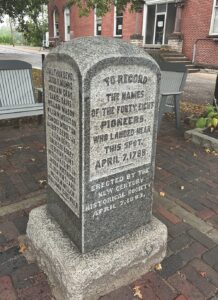Antietam

Scan the QR code to learn more about Rufus Dawes, Civil War General, prominent Marietta businessman and civic leader.
September 16, 1862, near Sharpsburg, Maryland: “There was a drizzling rain…the night was dismal. Nothing can be more solemn than a period of silent waiting for the summons to battle…,” recalls Mariettan Major Rufus R. Dawes, second in command of the Union Army Wisconsin 6th Volunteer Infantry Regiment. Quotes are from his book Service with the Sixth Wisconsin Volunteers. Dawes was a keen observer, noting not only the details but also the curious, along with his personal reactions.
About daylight, Confederate artillery opened up. The Wisconsin men were rousted from deep sleep. “We had marched ten rods, when whiz-z-z ! bang ! burst a shell over our heads; then another; then a percussion shell struck and exploded in the very center of the moving mass of men. It killed two men and wounded eleven…Thus opened the great battle of Antietam,… (on) September 17th, 1862.”
The regiment soon came under withering fire from rebels in the woods. “Company I under Capt John Kellogg heroically dashed across the field and drove them out.” Captain Brown of Company E was killed as his men passed through a gate. Years later, Major Dawes was haunted by the image of that young officer “shouting in a loud imperative voice the order I had given him…(as) a bullet passed into his open mouth, and the voice is silenced forever.”
“Colonel Bragg was shot…and his nerve, in standing up under the shock until he had (repositioned) his men…, was wonderful.” With Bragg wounded, Dawes took over command of the regiment. “I felt a great sense of responsibility, when thrown thus suddenly in command…” Hours later the men were elated when Bragg rejoined them despite being wounded. “We had thought him dead.”
Heavy enemy fire raked through their lines” like a scythe”, felling dozens. “But we…pushed on, loading, firing, and shouting as we advanced. There was…a reckless disregard of life, of everything but victory.” Though forced back, Dawes regrouped the remaining men around the Wisconsin colors. Nearly half of the original 314 officers and men had been killed or wounded. They fought on, clearing out rebels threatening an artillery position.
Captain Werner Von Bachelle, commanding Company F, was shot dead. He was respected by all; his loss was deeply felt. A Newfoundland dog “was his constant companion and was with him when he fell. Our men left the body when under fire. The dog stayed with his fallen master and was found two days later lying dead upon his body. We buried him with his master.”
Two days later the Confederates withdrew. The carnage was the worst that Rufus Dawes experienced before or after. Bodies were stacked in piles. Dawes noticed a horse appearing to rise. “Its head was held proudly aloft, and its fore legs set firmly forward. But like all surrounding it…, the horse was dead.”
Dawes wrote to his mother on Sept 18: “My Dear Mother : — I have come safely through two more terrible engagements with the enemy…Our splendid regiment is almost destroyed…nearly four hundred men killed and wounded in the battles…The men have stood like iron.” Relief, anguish, and pride are evident in his words.
Another prominent Mariettan gave his life that day. Colonel Melvin Clarke commanded the 36th Ohio Volunteer regiment. He was a successful lawyer who recruited Washington County men for the Union Army. Clarke soon felt obligated to serve. Late that day at Antietam he was killed by a large shell. The regiment fell back under heavy fire, but they carried Clarke’s body with them in a blanket, so great was his men’s admiration and respect for him.
September 17,1862, was the bloodiest day in American history before or since, with a tally of 22,727 dead, wounded, or missing on both sides.


